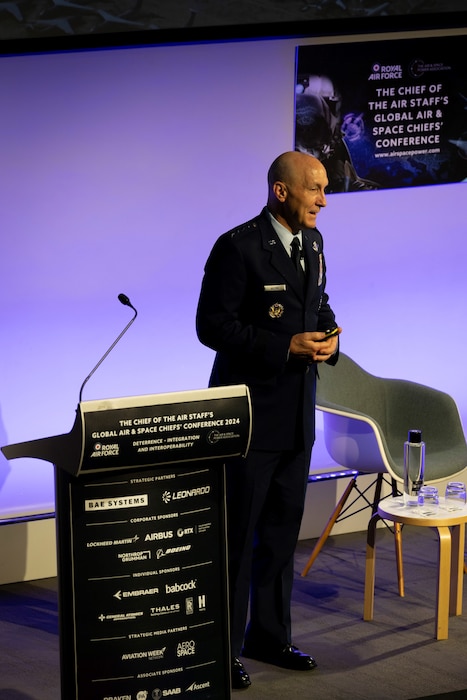U.S. Air Force Chief of Staff Gen. David W. Allvin emphasized the importance of "Collective Agility" during a keynote address to global leaders, industry partners, and academics in the air and space defense industry at the Global Air and Space Chiefs' Conference in London, July 18.
Allvin's remarks directly reflected the GASCC 2024 focus - deterrence, the importance of interoperability and integration to deter adversaries, and how Air and Space Forces can work together to seamlessly counter future threats.
"Interoperability and a high-level of integration are the building blocks of Collective Agility," Allvin said.
Collective Agility, as introduced and described by Allvin in London, expands upon his past statements that the U.S. Air Force must "solve for agility - initiating action in the right direction and building in the flexibility to learn and adjust while in motion. This is the spirit in which we must pursue the efforts to optimize for the environment we face."
To Allvin, solving for agility means adapting to the threat with a new kind of speed, power, and balance. In doing so, the U.S. Air Force's processes, operating procedures and decision-making will prove more responsive and effective in countering its pacing threat.
Collective Agility is achieved when every member of the fighting coalition is synchronized, acting and reacting in concert. Through dynamic and effective command and control, the entire coalition force package can have superior situational awareness and demonstrate the speed of recognition, decision, and action required to seize and maintain the initiative.
To demonstrate his point, Allvin showed imagery of birds flying in formation during his keynote. Each bird moves in perfect synchronization with its teammates; threats come, and the entire flock reacts as one.
"This is Collective Agility," Allvin said. "It can be a new form of combat power."
In a primer authored by Allvin and submitted to the conference for publication, Allvin wrote, "A single bird in the air or a fish in the ocean uses agility to effectively navigate through their domain, but a flock of predatory Harris' Hawks, or a school of barracudas are a force to be reckoned with. Their Collective Agility provides the movement and power to work together with tremendous effect. Individual squadrons throughout many of our air forces achieve this level of synchronicity. The challenge is synchronizing across larger, dissimilar units and, eventually across air forces."
For collective agility to become a reality amongst the Air Force and its allies and partners, increased information sharing and the prioritization of mission systems over singular platforms is fundamental, Allvin said.
In the same primer, Allvin penned "Integration starts with us. Common values like respect for sovereignty, liberty, and the rule of law form the foundation of our relationships. These relationships translate into strategic real-time intelligence sharing and culminate in integrated battlespace activities. The multinational collaboration we've seen in support of Ukraine over the past 28 months is an example of what's possible."
In the document, he went on to cite NATO's employment of standardized technology as a "promising first step" and described the rapid development of unmanned aerial systems, "embodying bleeding-edge lessons learned from the battlefield," as another example of what can be accomplished with true collaboration.
Allvin concluded the primer stating "Agility must extend beyond battlefield capabilities and permeate the very fibers of our relationships, resulting in institutional - and eventually - Collective Agility. This is our destination. We'll know we've reached it when, just like the school of fish as it changes direction, our actions appear seamless, guided by our common goals and enabled by our Collective Agility."
"We can do this together," he stated in his keynote. "This [Collective Agility] is the edge we can deliver over potential adversaries."
Allvin also warned time is of the essence, which is why the Department of the Air Force is reoptimizing itself for Great Power Competition.
"The risk on inaction is going up," Allvin said. "We have to open our eyes and look at the risks of inaction."







